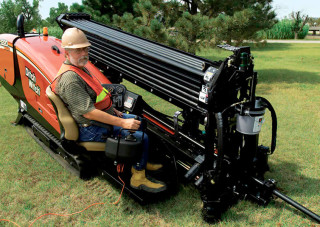Utilities

Directional drilling is a convenient, environment friendly and economical method used for installing underground oil, water, power, sewer, and gas conduits. In directional drilling, it requires holes bored angled the maximum of 90o after only some depth of drilling. Such forms of advanced methods offer easy, least impact access to different sites with some obstructions like railroads, waterways, streets, and buildings.
Since the tasks on directional drilling is quite complex, it requires the presence of functional pieces of equipment that will make them easier and for fast accomplishment. Some of the most advanced pieces of drilling equipment we use when conducting our drilling facilities include the following:
Drilling Barges
This drilling equipment is mostly used for shallow, inland water drilling. Typically, this is observed in swamps, canals, rivers, and lakes. Drilling barges are huge, floating platforms that should be towed through tugboat from a certain location to another. Appropriate for shallow, still waters, functional drilling barges are incapable to stand the movement of water common in huge open water conditions.
Semi-Submersible Rigs
These are the most typical form of offshore drilling rigs, which combine the functionality of submersible rigs having the capacity to drill in profound water. Semisubmersible rigs function on similar principle like submersible rigs. This is through deflating and inflating of its inferior hull. However, the primary difference it has with semisubmersible rigs is that whenever the air is released off the inferior hull, the rigs don’t immerse to the sea floor. Rather, the rig is partly submerged, yet it still floats on the drill spot.
While drilling, the inferior hull, which is filled with water, offers steadiness to the rig. With the use of huge anchors, semisubmersible rigs are brought in position. Every anchor weighs more than ten tons. Mixed with the rig’s submerged part, these anchors make sure that the used platform is safe and stable enough to be utilized in offshore turbulent waters.
Jack-Up Rigs
Jack-up rigs are comparable to drilling barges having a single difference. Once jack-up rigs are towed to the drilling spot, 3 or 4 legs will be lowered till they reach the sea floor. This enables the functioning platform to lie above the water’s surface, different from a floating barge. However, jack-up rigs are appropriate for shallower waters, since extending those legs down extremely deeper will be impractical. Typically, such rigs are more secure to deal with as compared with drilling barges. This should be true since their functioning platform is put a bit higher than the water level.
Tension Leg Platforms
This drilling equipment consists of the floating rig, quite comparable to the semisubmersible form. An inferior hull will be filled with water on drilling. This improves the platform’s stability against water and wind movement. However, in addition to this, semisubmersible rig platforms also fit in a tension leg system. This tension leg is hollow, long tendon, which extends right from the seafloor going to the hovering platform. The legs are maintained on constant tension, and don’t enable for any down or up movement of the platform. On the other hand, their flexibility allows for side to side movement, for up to 20ft.
With the use of these innovative pieces of drilling equipment, you can guarantee the best services from us.

